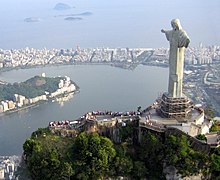Christ the Redeemer (statue)
22°57′5″S 43°12′39″W / 22.95139°S 43.21083°W

Christ the Redeemer (Portuguese: Cristo Redentor), is a statue of Jesus Christ in Rio de Janeiro, Brazil.[1] The statue stands 39.6 metres (130 feet) tall, weighs 700 tons, and is located at the peak of the 700-m (2296-foot) Corcovado mountain in the Tijuca Forest National Park overlooking the city.[1][2][3]
A symbol of Christianity, the statue has become an icon of Rio and Brazil.[4]
History
The idea for erecting a large statue atop Corcovado had been around since mid 1850s, when Catholic priest Pedro Maria Boss requested financing from Princess Isabel to build a large religious monument. Princess Isabel did not think much of the idea, which was completely dismissed in 1889, when Brazil became a Republic, with laws mandating the separation of church and state.[5]
The second proposal for a large landmark statue on the mountain was made in 1921 by the Archdiocese of Rio de Janeiro.[citation needed] The archdiocese organized an event called Semana do Monumento ("Monument Week") to attract donations. The donations came mostly from Brazilian Catholics.[1] The designs considered for the "Statue of the Christ" included a representation of the Christian cross, a statue of Jesus with a globe in his hands, and a pedestal symbolizing the world.[citation needed] The statue of Christ the Redeemer with open arms was chosen.

Local engineer Heitor da Silva Costa designed the statue; it was sculpted by Paul Landowski, a French monument sculptor of Polish origin.[6][1] A group of engineers and technicians studied Landowski's submissions and the decision was made to build the structure out of reinforced concrete (designed by Albert Caquot) instead of steel, more suitable for the cross-shaped statue.[5] The outer layers are soapstone, chosen for its enduring qualities and ease of use.[2] Stone for the monument was taken from Limhamn, in Malmö, Sweden.[citation needed] Construction took five years — from 1926 to 1931 and the monument was opened on October 12, 1931.[2][3] The cost of the monument was $250,000.[7]
Recognitions and honors
In October 2006, on the statue's 75th anniversary, Archbishop of Rio Cardinal Eusebio Oscar Scheid consecrated a chapel (named for the patron saint of Brazil - Nossa Senhora Aparecida) under the statue.[3] This allows Catholics to hold baptisms and weddings there.[3]
As of 7 July, 2007, Christ the Redeemer was named one of the New Seven Wonders of the World in a list compiled by the Swiss-based The New Open World Corporation.[8]
See also
- Cristo-Rei in Portugal. A 28 meter tall replica of Christ the Redeemer
- Christ of the Ozarks in Arkansas, USA. A 20 meter tall statue inspired by Christ the Redeemer
- Christ the Redeemer of the Andes
- List of statues
- List of statues by height
References
- ^ a b c d "Largest Christ". TIME. 1931-10-26. Retrieved 2007-07-11.
- ^ a b c "Brazil: Crocovado mountain - Statue of Christ". Travel Channel. Retrieved 2007-07-07.
- ^ a b c d "Sanctuary Status for Rio landmark". BBC. 2006-10-13. Retrieved 2007-07-07.
- ^ "The new Seven Wonders of the world". Hindustan Times. 2007-07-08. Retrieved 2007-07-11.
- ^ a b "O Dia Online - Cristo Redentor". Retrieved 2007-11-07.
- ^ gyugiyPhillips, Martin (2007-06-16). "Vote now for Phonehenge". The Sun. Retrieved 2007-07-11.
- ^ "Brazil Dedicates Statue of Redeemer: Marconi Illuminates Gigantic Figure by Short-Wave Radio from Rome". New York Times. 1931-10-13.
{{cite news}}:|access-date=requires|url=(help) - ^ "Global vote picks Seven Wonders". BBC. 2007-07-07. Retrieved 2007-07-11.
